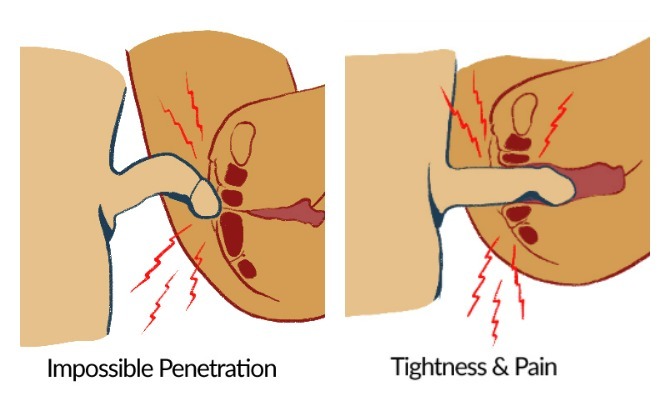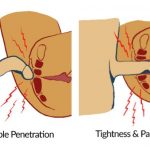What You Need To Know About Vaginismus

There are people suffering from a condition called Vaginismus and aren’t even aware. This condition involves a muscle spasm in the pelvic floor muscles. It can make it difficult, impossible or painful to have sexual intercourse, insert a tampon or undergo a gynaecological exam. The vagina tightens up when you try to insert an object such as a penis, tampon or speculum into it, because of an involuntary contraction of the pelvic floor muscles. It does not prevent people from becoming sexually aroused, but they may become anxious about sexual intercourse so that they try to avoid sex or vaginal penetration.
This leads to generalized muscle spasm, pain and temporary cessation of breathing.
The most common muscle group affected is the pubococcygeus (PC) muscle group. These muscles are responsible for urination, intercourse, orgasm, bowel movements and childbirth.
We have different types of vaginismus such as Primary Vaginismus, Secondary Vaginismus, Global Vaginismus and Situational Vaginismus.
Vaginismus Symptoms
It varies among individuals and it includes:
- painful intercourse(dyspareunia), with tightness and pain that may be burning or stinging
- penetration being difficult or impossible
- long-term sexual pain with or without a known cause
- pain during tampon insertion
- pain during a gynaecological examination
- generalized muscle spasm or breathing cessation during attempted intercourse
Causes of Vaginismus
Vaginismus is a condition which can be caused by physical stressors, emotional stressors, or both. It can become anticipatory so that it happens because the person expects it to happen.
Emotional triggers
- fear, for example, of pain or pregnancy
- anxiety, about performance or because of guilt
- relationship problems, for example, having an abusive partner or feelings of vulnerability
- traumatic life events, including rape or a history of abuse
- childhood experiences, such as the portrayal of sex while growing up or exposure to sexual images
Physical triggers
- infection, such as a urinary tract infection(UTI) or yeast infection
- health conditions, such as cancer or lichen sclerosis
- childbirth
- menopause
- pelvic surgery
- inadequate foreplay
- insufficient vaginal lubrication
- medication side effects
Treatment
To diagnose vaginismus, a doctor will take a medical history and carry out a pelvic examination. Treatment may involve different specialists, depending on the cause.
Any possible underlying causes, such as an infection, may need to be ruled out or treated first, before focusing on the vaginismus.
The aim of treatment will be to reduce the automatic tightening of the muscles and the fear of pain and to deal with any other type of fear that may be related to the problem.
Treatment usually includes a combination of the following:
Pelvic floor control exercises: These include muscle contraction and relaxation activities, or Kegel exercises, to improve control of the pelvic floor muscles.
Education and counselling: Providing information about the sexual anatomy and sexual response cycle can help the individual understand their pain and the processes their body is going through.
Emotional exercises: This can help the person identify, express, and resolve any emotional factors that may be contributing to their vaginismus.
Reducing sensitivity to insertion: A woman will be encouraged to touch the area as close as possible to the vaginal opening every day without causing pain, moving closer each day. When she is able to touch the area around the vagina, she will be encouraged to touch and open the vaginal lips, or labia. The next step will be to insert a finger.
Insertion or dilation training: Once a woman can do this without pain, she will learn to use a plastic dilator or a cone-shaped insert. If she can insert this without pain, the next step will be to leave it in for 10 to 15 minutes, to let the muscles get used to the pressure. Next, she can use a larger insert, and then she can teach her partner how to apply the insert.
When the woman feels comfortable with this, she can allow her partner to put his penis near the vagina, but not inside. When she is completely comfortable with this, the couple can try intercourse again. They may wish to build up gradually to this, as with the insert.
The time it takes for vaginismus to be successfully treated will depend on the individual and it’s very rare that vaginismus needs surgery.
Source: Medical News Today







